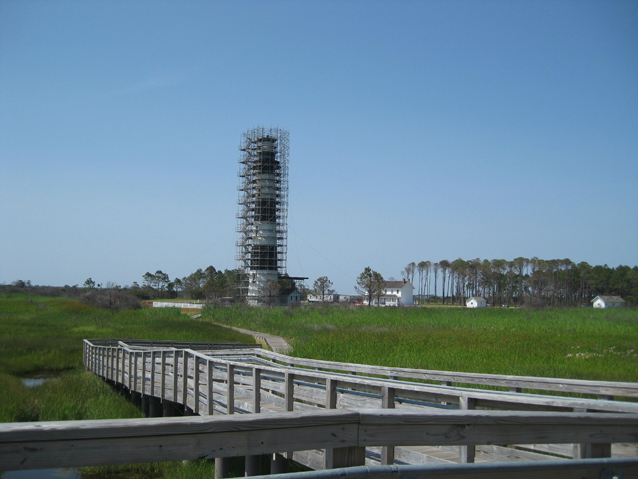
National Park Service
The third (and current) Bodie Island Light Station has gone through a number of modifications and repairs since the tower first shone its light on October 1, 1872. Listed below are some of the notable repairs and modifications that have taken place in the last 144 years.
On October 29, 1872, less than one month after the lighthouse began operation, a flock of geese flew into the tower, seriously damaging the first-order Fresnel lens. To prevent further damage of this type, a screen was installed to protect the glass portion of the lantern.
In the first decade of operation, lightning proved to be a major problem, as the interior iron stairway acted as a lightning rod, resulting in small cracks on the interior wall of the tower. In 1884, the Light-House Board finally approved the installation of a cable inside the tower that would run from the lantern to a cast iron plate buried in the ground.
In 1896, the substitution of mineral oil (kerosene) for the original lard oil as fuel necessitated the construction of a sheet metal oil house.
In 1898, the telephone arrived at Bodie Island. The War Department determined that national defense could be served if several lighthouses on the North Carolina and Virginia coasts were tied into existing lines connecting Life Saving Stations on the Outer Banks.
In 1934, under President Franklin Roosevelt’s New Deal policies, artificial protective sand dunes were erected from the Virginia border south to Ocracoke Inlet, including the area near the Bodie Island Light Station.
Under National Park Service jurisdiction, the double keepers’ quarters underwent a massive repair campaign from 1990 to 1992 that addressed several issues and restored the alignment of the west front walk. This included making the site fully accessible and constructing a new restroom building north of the double keepers’ quarters in 1992.
In 1997, after years of analysis, it was determined that the unsupported iron staircase was too dangerous for public climbing. A chief concern was the condition of the metal parts, particularly those of the deck supporting the lantern and surrounding galleries and ornamental ironwork. The report warned of falling metal parts; in response, the National Park Service cordoned off the area around the lighthouse to protect visitors from falling debris.
In 2010, a new boardwalk, a gift from the State of North Carolina, was constructed at the edge of the north parking area.
Following the completion of a historic structure report for the lighthouse/oil house and preservation/rehabilitation plan, the North Carolina Department of Cultural Resources concurred in 2007 with a determination of no adverse effect, provided that the number of stair treads replaced did not exceed 21. The federal Omnibus Budget Bill of 2009-2010 included long-awaited funding for repair and replacement of ironwork as well as repair of masonry and stone, repair of floors and other interior treatments, lead paint abatement, painting, and installing new handrails and a fire suppression system. The project was completed in December, 2012 and the National Park Service officially opened the lighthouse for public climbing for the first time in April, 2013.
Last updated: September 28, 2016
